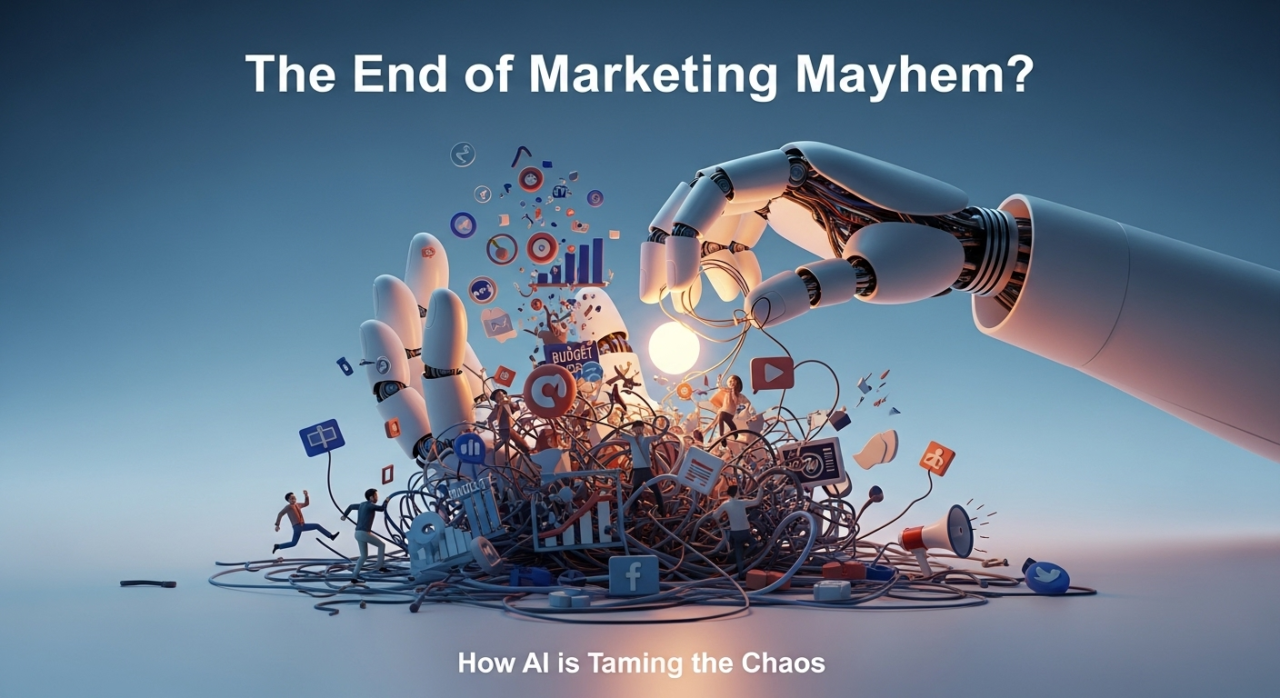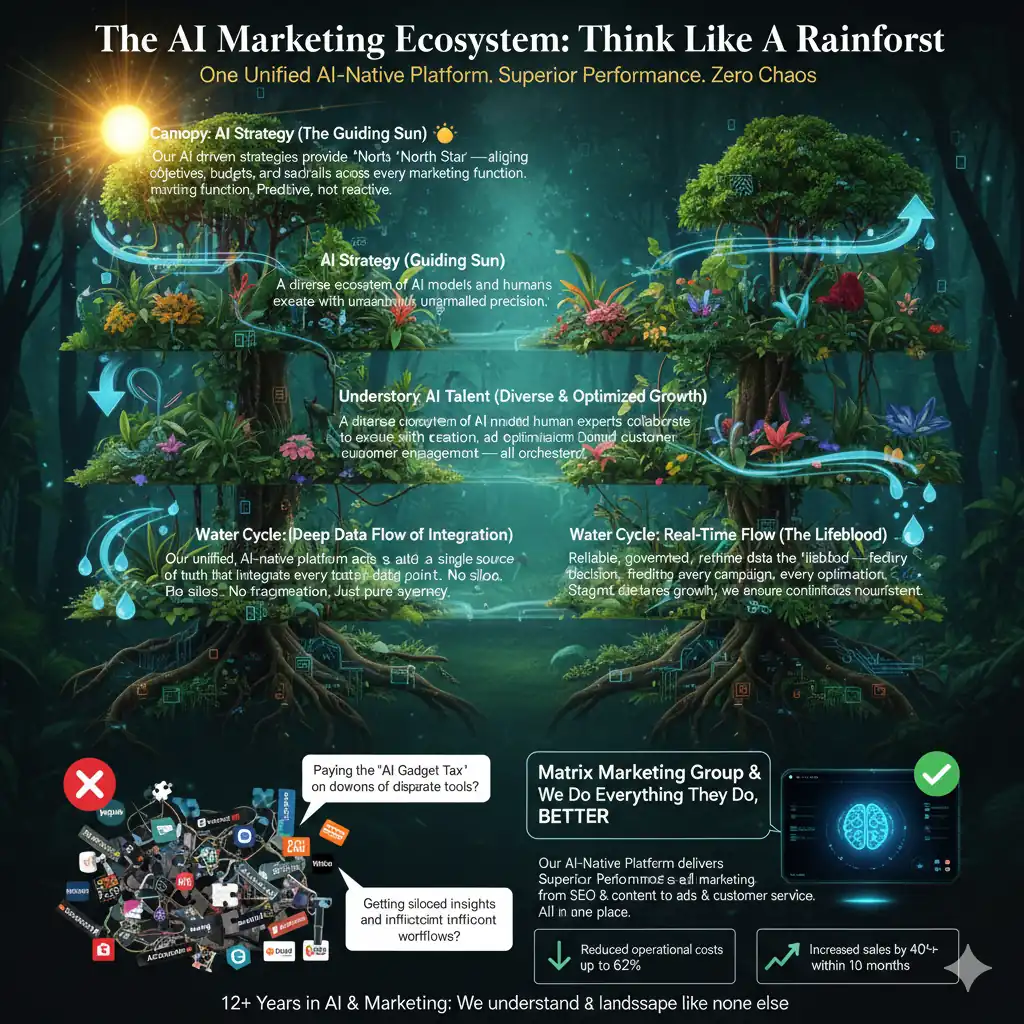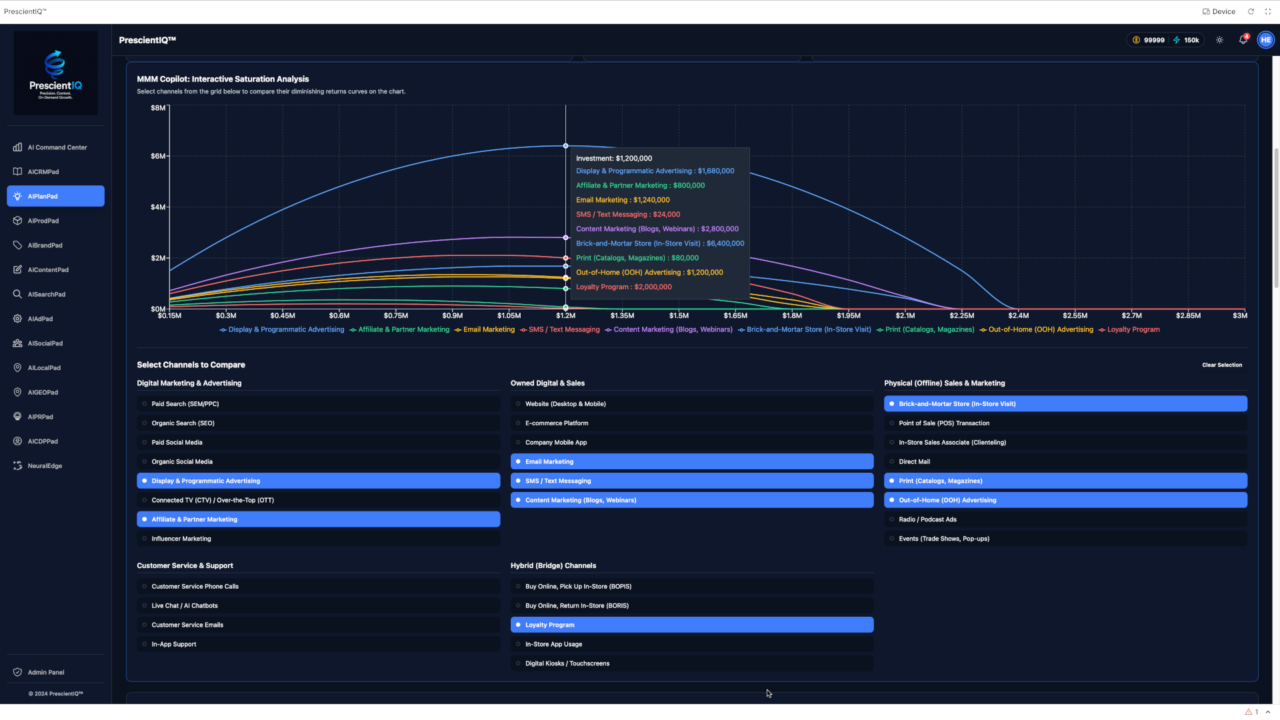The End of Marketing Mayhem? How AI is Taming the Chaos
Learn How to End the Marketing Mayhem. How AI is Taming the Chaos.
I. Introduction: The Wild West of Marketing is Closing Down Shop
Remember those days when marketing felt like a frantic scramble, a perpetual chase after fleeting trends, and a constant exercise in putting out fires?
That era of unpredictable, reactive marketing – a state of affairs we might aptly term “Marketing Chaos” – is, for those ready to embrace change, decidedly drawing to a close.
“The Era of Marketing Chaos is Over” isn’t a proclamation of instant orderliness.
It’s a recognition of a profound shift: a move away from knee-jerk reactions to the cacophony of the market, and towards the proactive construction of intelligent, adaptive, and, dare I say, autonomous marketing systems, systems fundamentally powered by the transformative capabilities of Artificial Intelligence.
In this exploration, we’ll dissect this “chaos”—what it embodies and the conditions that enable it.
We’ll consider who finds themselves most ensnared by its turbulent currents, examine the prevailing industry discourse (including the valuable insights of George Schildge!), and illuminate how AI is emerging as a crucial lifeline.
Finally, we’ll delve into why a company like Matrix Marketing Group is positioned at the forefront of this paradigm shift.
II. What Exactly is This “Marketing Chaos,” Anyway?

Let’s define the beast. “Marketing Chaos” describes the highly dynamic, often unpredictable environment in which modern marketers must operate.
It’s not merely a buzzword, but a confluence of forces:
- The Relentless March of Technology: Technological evolution, particularly the emergence and rapid proliferation of Generative AI, has fundamentally reshaped the marketing landscape. The speed of innovation itself contributes to a sense of instability.
- The Ever-Shifting Sands of Consumer Behavior: Today’s consumers exhibit rapidly evolving behaviors and an almost insatiable appetite for instant gratification. Marketing strategies must adapt in real-time to capture their attention in an increasingly noisy world.
- The Proliferation of Channels and Data: The digital realm has exploded with new channels, leading to exponential growth in data. This deluge of information often leads to overload, making it difficult to discern meaningful signals from noise.
- The Butterfly Effect in Action: The marketing landscape is susceptible to the “butterfly effect,” in which seemingly insignificant changes can trigger massive, unforeseen consequences. A single misstep in a campaign can have ripple effects, damaging brand reputation and impacting revenue.
This chaotic environment creates very tangible business problems:
- The Absence of a Coherent Strategy: Marketers, adrift in the chaos or AI drift, often resort to what can only be described as “throwing darts in the dark.” Without a clearly defined target audience (“Who”) or a methodical approach (“How”), marketing efforts become scattershot and ineffective. But the most important question is, why did it happen, and why didn’t we know about it?
- The Perennial Problem of Silos: The lack of alignment between sales and marketing teams is a persistent issue that leads to wasted resources, missed opportunities, and, ultimately, a decline in revenue. Frustration mounts as teams work at cross-purposes, undermining the overall effectiveness.
- The Data Deluge and the Insight Drought: Organizations are drowning in data, yet thirsting for actionable insights. The sheer volume of information, often fragmented and poorly organized, leads to “analysis paralysis.” Companies find themselves “burning cash chasing bad strategy” because they lack the ability to extract meaningful intelligence from their data.
- The Unmanageable Volume of Content: In the age of content marketing, many organizations find themselves overwhelmed by the sheer volume of content they are producing. This content is often outdated, irrelevant, or lost in the digital ether, failing to achieve its intended purpose.
III. The Real Cost: Why Marketing Mayhem Hurts Your Bottom Line
From “Are we using AI?” to “What ROI are we compounding?”
The C‑suite has moved on. Today’s mandate: prove cash‑flow impact, build a sustainable data moat, and turn AI from a cost center into a compounding advantage.
Executive KPI Snapshot
5 Pillars of Demonstrable AI ROI
Back‑of‑Napkin: What Could This Be Worth?
Board‑Ready Questions to Answer
Marketing chaos isn’t simply an inconvenience; it’s an insidious force that erodes brand trust, squanders precious budget, stifles growth, and, perhaps most importantly, burns out the very teams charged with driving success.
It directly undermines your ability to engage customers, foster loyalty, and ultimately generate revenue.
The statistics paint a stark picture:
The Communication Breakdown:
A staggering 35% of marketers identify a lack of effective communication between sales and marketing teams as a primary obstacle to growth.
This disconnect manifests in missed opportunities, duplicated efforts, and a general lack of synergy that hinders overall performance.
The MarTech Labyrinth:
The marketing technology (MarTech) ecosystem has exploded, now boasting over 11,000 tools. This proliferation, rather than simplifying processes, often creates a complex and fragmented landscape.
Tool sprawl leads to disconnected systems, integration nightmares, and a general sense of overwhelm that undermines efficiency.
IV. Who’s Feeling the Heat? Industries Grappling with Chaos

The impacts of marketing chaos are far-reaching, touching a diverse range of industries.
While some sectors are more acutely affected than others, the underlying challenges are surprisingly universal:
Multi-location Businesses:
Businesses with multiple physical locations (think restaurants, banks, healthcare providers, and insurance agencies) often struggle with “local marketing chaos.” Inconsistent brand messaging across locations, difficulty tracking local campaign performance, and a lack of centralized control can lead to a fragmented and ineffective marketing effort.
Rapidly Growing Marketing Agencies:
Marketing agencies experiencing rapid growth often face operational challenges as they scale.
Project delays, communication breakdowns, and client trust issues can arise if agencies lack the systems and processes necessary to manage growth effectively.
B2B and B2C Sectors:
Both sectors are constantly grappling with evolving target audiences and shifting consumer preferences.
Adapting marketing strategies quickly and effectively is paramount in these dynamic environments.
Hospitality & Airlines:
The hospitality and airline industries are particularly vulnerable to external disruptions and market volatility.
Economic downturns, natural disasters, and geopolitical events can significantly impact demand, requiring these industries to be highly agile and responsive.
E-commerce:
Rapid shifts from opportunity to risk characterize the e-commerce landscape.
Changing consumer behavior, increasing competition, and technological advancements require e-commerce businesses to adapt their marketing strategies.
Established Manufacturing & Delivery Cycles:
Supply chain disruptions and demand shifts have particularly hard hit industries with established manufacturing and delivery cycles.
Optimizing these processes and adapting to changing market conditions is critical for survival.
Beneath the surface of these industry-specific challenges lie a set of fundamental tasks that organizations struggle to accomplish:
Achieving Predictable Revenue Growth:
Organizations are constantly striving for predictable, sustainable revenue growth. However, in a chaotic marketing environment, it can be difficult to forecast demand and optimize customer acquisition costs accurately.
Delivering Personalized Customer Experiences:
Customers expect a consistent, personalized experience across all touchpoints.
However, delivering this level of personalization at scale requires sophisticated data management and AI-powered marketing automation.
Transforming Data into Actionable Insights:
Organizations are awash in data, but often struggle to turn it into actionable insights.
The challenge lies in identifying meaningful patterns and trends that can inform strategic decision-making.
Creating High-Quality Content at Scale:
The demand for high-quality, lead-generating content is relentless.
Organizations struggle to produce enough content to meet their target audiences’ needs while maintaining brand consistency and quality.
Ensuring Seamless Alignment Between Teams:
Seamless alignment between sales, marketing, and operations is essential for driving revenue growth and delivering exceptional customer experiences.
However, achieving this alignment often requires breaking down silos and fostering collaboration across departments.
Adapting to Technological Advancements:
The pace of technological change is accelerating, requiring organizations to adapt their marketing strategies to new tools and platforms.
Failure to keep up with these advancements can lead to a competitive disadvantage.
V. The Great Debate: Is Chaos Truly Over, or Just Evolving?

The question of whether marketing chaos is truly over is a subject of ongoing debate.
Some experts argue that rather than attempting to eliminate chaos, marketers should learn to “embrace” it, leveraging unpredictability through agile experimentation and authentic connections.
The very concept of “chaos marketing” – a deliberate and often unconventional approach – suggests that a degree of unpredictability can be a source of virality and engagement.
However, George Schildge, CEO and Chief AI Industry Architect at MatrixLabX, offers a contrasting perspective. He asserts that “the era of marketing chaos is over” for those who strategically adopt AI.
Schildge’s key insight is that simply layering AI onto existing, inefficient workflows only automates chaos, amplifying the problems.
Implementing AI without a fundamental rethinking of marketing processes is akin to putting a high-performance engine in a broken-down car.
Instead, Schildge advocates for “AI autonomy” – building AI-native systems designed to adapt, optimize, and coordinate independently.
This requires:
- Clean, High-Quality Data: AI is only as good as the data it is trained on. Accurate, complete, and well-organized data is essential for AI to function effectively.
- Custom-Built AI Agents: Generic AI solutions often fall short of meeting the specific needs of individual organizations. Custom-built AI agents, tailored to specific marketing objectives, are more likely to deliver meaningful results.
- Continuous Learning and Improvement: AI systems should be designed to learn and improve continuously. This requires ongoing monitoring, evaluation, and refinement of AI models.
- Talent and Technology: like the three-legged stool, it will not stand up with all three. You need strategy, talent, and technology to work holistically, which can be achieved with casual AI and quantum computing.
The real competitive advantage, according to Schildge, lies not in whether you use AI, but in how you use it. It’s about redesigning marketing processes from the ground up to be AI-native, creating systems that are inherently more intelligent, adaptable, and efficient.
This perspective is not without its critics.
The debate over the merits of “unhinged” content (authentic or just noise?) continues, as do the ethical implications of AI autonomy (human creativity vs. machine efficiency) and the potential for “AI chaos” (tool overload, random experiments).
VI. From Chaos to Clarity: How AI is Stepping Up
AI offers a pathway from chaos to clarity, transforming the marketing landscape in profound ways:
Beyond Automation:
Strategic AI Solutions: AI is not simply about automating mundane tasks.
It’s about developing strategic solutions that address the fundamental challenges of marketing chaos.
AI-Powered Predictive Strategy: Beyond simply automating tasks, the next step is for AI to move from automation to prediction, enabling highly accurate forecasting of market trends, customer behavior, and campaign outcomes.
This allows CMOs to proactively adjust strategies and allocate resources for optimal impact.
Autonomous Marketing Operations: The evolution moves towards truly autonomous systems where AI agents manage and optimize entire marketing campaigns end-to-end, from content creation and distribution to real-time bidding and performance adjustments.
Human marketers then shift to higher-level strategic oversight and creative direction.
Transform your marketing from reactive chaos to proactive, self-optimizing growth. Our autonomous AI systems manage and enhance entire campaigns end-to-end, freeing your team to focus on high-level strategy and creative innovation and ensuring consistent, predictable results.
PrescientIQ: Go beyond analytics. PrescientIQ is your unified causal intelligence platform that not only tells you what happened but why, and precisely what to do next.
With explainable AI and predictive foresight, we enable smarter budget allocation, hyper-personalization, and guaranteed on-demand growth.
Causal Intelligence and Explainable AI: CMOs will leverage AI not just to identify correlations, but to understand the underlying causal relationships between marketing activities and business outcomes.
This “glass-box” approach, providing explainable insights into why things happen, fosters greater trust in AI systems and enables more precise, impactful decision-making.
AI for Efficiency:
AI can automate a wide range of tasks, including content drafting, social media scheduling, and data analysis, freeing up marketers to focus on more strategic activities.
Data-Driven Decision Making:
AI can sift through massive datasets to provide real-time, actionable insights, helping marketers avoid analysis paralysis and make more informed decisions.
Hyper-Personalization at Scale:
AI enables marketers to tailor messages, offers, and experiences to individual consumers, fulfilling the promise of true personalization.
Unified MarTech Stacks:
AI can integrate disparate marketing tools into a “single source of truth,” providing a more holistic view of the customer journey and enabling more consistent messaging.
Agile Marketing Frameworks: AI enables rapid testing and optimization, allowing marketers to pivot quickly in response to market shifts and changing consumer behavior.
VII. Matrix Marketing Group: Your Guide to the AI-Native Marketing Frontier
Matrix Marketing Group and MatrixLabX are not just another agency or tech provider.
We are the architects of your AI-powered marketing future, embedding AI into the very core of your marketing to deliver predictable, accelerated growth. Precision. Context. On-Demand Growth.
Our Unfair Advantage (Why We’re Different):
AI-Native & Autonomous:
We don’t just use AI; we build AI-native processes and an autonomous operating system (PrescientIQ) designed to dismantle chaos from within, focusing on LLM optimization from the ground up.
Performance-Based Pricing:
We tie our success directly to your measurable ROI, moving beyond bloated agency fees.
“Glass-Box” Transparency:
We believe in owning your marketing intelligence, not renting black-box solutions. Our platform offers clear insights into why outcomes occur.
Unified Causal Intelligence:
Our proprietary PrescientIQ platform explains why things happen and prescribes what to do next, moving beyond correlation to true causality and pre-factual foresight.
MatrixLabX’s Quantum Computing AI in Marketing: A Glimpse into the Future

While George Schildge’s mention of “quantum computing” in the context of “talent and technology” might seem forward-looking, its direct application to marketing is still in its early stages.
However, understanding the theoretical implications and potential future applications of Google’s quantum computing advancements can offer a glimpse into a truly autonomous and hyper-intelligent marketing landscape.
What is Quantum Computing?
Google is a leading player in developing quantum computers. Unlike classical computers that store information as bits (0 or 1), quantum computers use “qubits,” which can represent both 0 and 1 simultaneously through a phenomenon called superposition.
This allows quantum computers to process vast amounts of information and perform calculations at speeds unimaginable for even the most powerful supercomputers today, particularly for certain types of problems.
PrescientIQ is built on Google’s technology foundation, and Google’s quantum AI research focuses on leveraging this immense computational power to solve complex problems in fields like drug discovery and artificial intelligence.
When applied to AI, quantum computing could dramatically accelerate machine learning, enable the development of far more sophisticated algorithms, and unlock entirely new capabilities beyond our current reach.
How MatrixLabX Sees Quantum Computing AI Relates to Marketing (Applications)
The connection between Google’s quantum computing AI and MatrixLabX charter lies in its potential to revolutionize the underlying “intelligence” that drives marketing systems.
If AI is already taming marketing chaos, quantum AI could deliver the ultimate clarity, prediction, and autonomy.
Here’s how it could relate: Unlocking True Causal Intelligence: Current AI can identify correlations, and advanced AI like PrescientIQ can infer causality.
However, quantum AI could potentially model the incredibly complex, multi-dimensional causal relationships in marketing with unprecedented accuracy.
This means understanding not just “why” something happened, but the full, nuanced chain of events and their probabilities, allowing for truly prescient foresight.
Hyper-Optimized Marketing Mix Modeling: Imagine an AI that can instantly evaluate billions of potential budget allocations across thousands of channels, offers, and creative variations, factoring in real-time market shifts, individual consumer behavior, and competitive actions.
Quantum computing could make this level of instantaneous, global optimization possible, finding marketing efficiencies and opportunities that are currently invisible.
Quantum Personalization: Beyond today’s hyper-personalization, quantum AI could enable “quantum personalization.”
This would involve understanding and predicting individual customer journeys with such precision that marketing interventions are not just tailored, but pre-emptive and perfectly timed, responding to a customer’s potential future states and needs before they even fully manifest.
This aligns with the concept of the “Quantum Customer” mentioned in the document.
Autonomous Marketing Systems: The “AI autonomy” envisioned by George Schildge could reach its ultimate expression with quantum AI.
These systems would be self-learning, self-optimizing, and capable of adapting to market changes at a speed and complexity that would eliminate the need for human intervention in many operational aspects, allowing human marketers to focus purely on high-level strategy and creativity.
And with the ability to generate a unique digital signature or buy a customer’s signature, you will find that customer satisfaction jumps exponentially because they’re getting what they want when they want it, and how they want to consume it.
Most B2B customers struggle with fragmented buying journeys, slow time-to-value, and unclear ROI, which erode trust and stall expansion.
By unifying data, automating onboarding, and co-owning measurable outcomes, the provider turns the relationship into a low-friction, high-clarity partnership.
The result is faster adoption, provable business impact, and a customer who becomes a long-term advocate rather than a transactional buyer.
Predicting Black Swan Events: Quantum computing’s ability to model complex systems and probabilities will help marketing systems anticipate rare, high-impact “black swan” events (such as supply chain disruptions or sudden shifts in consumer sentiment) with greater accuracy than current probabilistic models.
Application Examples (Future-Gazing)
While these are long-term projects, here are some speculative application examples of Google’s quantum computing AI in marketing and PrescientIQ:
- Real-time Global Campaign Optimization: A quantum AI platform monitors global market conditions, social sentiment, competitor actions, and individual customer behavior across all channels simultaneously. It then makes instantaneous, optimized adjustments to ad bids, creative variations, channel allocations, and even pricing strategies across millions of campaigns worldwide to maximize ROI in real time, preempting potential underperformance.
- Predictive Product Launch Success: Before a new product even enters development, a quantum AI analyzes vast datasets (market trends, consumer psychology, past product failures/successes, competitive landscapes) to predict its potential market reception with extremely high accuracy, providing granular insights into ideal features, messaging, and target demographics for guaranteed success.
- Ultra-Personalized “Thought-Partner” Chatbots: Instead of just answering questions, a quantum AI-powered chatbot acts as a dynamic “thought-partner” for consumers, anticipating their needs and preferences, suggesting products or services before the consumer is consciously aware they desire them, and guiding them through a hyper-personalized, seamless buying journey.
- Self-Evolving Content Creation: A quantum AI system continuously generates and optimizes content (text, images, video) across all platforms, not just based on current performance, but by predicting future content trends and audience engagement patterns with such accuracy that it consistently produces viral, high-converting content autonomously.
- Automated Crisis Prevention & Management: The AI can detect the faintest signals of potential brand reputation issues or market disruptions (e.g., negative sentiment brewing on obscure forums) and autonomously deploy counter-measures, such as targeted messaging, proactive customer service interventions, or even adjusting product availability, before a crisis fully escalates.
It’s crucial to reiterate that these are future visions.
The current practical applications of quantum computing in marketing are still years away.
However, the advancements Google and others are making in quantum AI will undoubtedly lay the groundwork for a marketing future that is far more intelligent, adaptive, and autonomous than anything we can fully comprehend today.
Applications that End the Chaos
1. PrescientIQ – Unified Causal Intelligence:
Our core platform replaces fragmented data and reactive strategies with predictable, data-driven foresight. Unified casual intelligence puts us in the forefront rather than looking to history.
It explains why outcomes occur and prescribes what to do next, enabling smarter budget allocation, quantum personalization, and explainable action.
2. AICRMPad (from MatrixLabX’s AIPads suite):
An AI-native CRM for sales reps and managers.
It sells with you, automating busywork to deliver +28-41% more qualified meetings, saving 2-4 hours/rep/day, and providing forecasts within 3-7% of actuals.
3. AI Marketing Modeling Platform:
Unifies Marketing Mix Modeling (MMM), Multi-Touch Attribution (MTA), and Customer Lifetime Value (CLV) modeling to optimize high-dimensional decisions across budget, channel, and offer, finding value others miss.
VIII. Real-World Wins: Case Studies in Chaos Conquering
Case Study 1: The B2B SaaS Breakthrough
Challenge: A rapidly scaling B2B SaaS client was experiencing “AI chaos” – too many tools, inconsistent lead quality, high Customer Acquisition Cost (CAC), and sales-marketing misalignment. They struggled to attribute revenue directly to marketing efforts.
Matrix Marketing Group Solution: Implemented PrescientIQ’s Unified Causal Intelligence to untangle their data and deployed AICRMPad for sales automation and insights. Matrix Marketing Group provided strategic guidance on AI-native process redesign.
Results:
- +38% increase in qualified sales meetings, directly attributed to optimized outreach and AI-personalized communications via AICRMPad.
- CAC was reduced by 28% within six months by precisely identifying and amplifying causal drivers of conversion.
- Sales reps saved an average of 3 hours per day on CRM hygiene and follow-up, enabling them to focus on high-value interactions.
- Sales forecasts improved to within 5% of actuals using PrescientIQ’s predictive models.
Case Study 2: Re-ordering the Multi-location Retail Landscape
Challenge: A national home services franchise faced “local marketing chaos,” with brand inconsistencies across hundreds of locations, difficulty tracking local campaign ROI, and overwhelming content production demands for local teams.
Matrix Marketing Group Solution: Leveraged PrescientIQ’s AI Marketing Modeling Platform for optimized budget distribution across local digital channels and utilized AIContentPad for scalable, localized content generation and distribution, ensuring brand compliance.
Results:
- Achieved an impressive 4.5x Return on Ad Spend (ROAS) on their AI marketing program, demonstrating clear revenue impact.
- Operational costs for content creation and campaign management were reduced by 20%, freeing up budget for more strategic initiatives.
- Brand consistency across all locations improved by 45%, enhancing customer trust and recognition.
- Localized campaigns delivered forecasts within 6% of actual performance, allowing proactive adjustments for maximum impact.
IX. Gazing into the Crystal Ball: What’s Next for Marketing?
AI Takes the Wheel (More Smartly):
Expect AI to continue driving hyper-personalization, conversational marketing (chatbots, virtual assistants), and even more sophisticated content creation.
The future of marketing will be characterized by AI-powered systems that can anticipate customer needs and deliver personalized experiences in real time.
Immersive Experiences:
Virtual Reality (VR) and Augmented Reality (AR) will become mainstream marketing channels for engaging, interactive brand experiences (think virtual try-ons and AR showrooms).
AR’s global revenue is projected to hit $39.8 billion by 2027. These technologies will enable brands to create immersive experiences that blur the lines between the physical and digital worlds.
The First-Party Data Revolution:
With third-party cookies phasing out by Q3 2025, marketers will double down on collecting first- and zero-party data, building direct relationships and privacy-compliant personalization.
Brands will need to build their own data moats by collecting and managing customer data directly in a privacy-compliant manner.
Beyond Search Engines:
Younger generations are increasingly using social platforms like TikTok and Instagram for search, which is driving the need for new SEO and content strategies.
By 20284, over half of all online searches are expected to be voice-activated. Marketers will need to adapt their SEO and content strategies to these new search paradigms, focusing on visual and voice-optimized content.
Ethical & Sustainable Marketing:
Brands that align with social and environmental causes will build lasting trust, as 50% of consumers rank sustainability as one of their top five value drivers.
Consumers are increasingly demanding that brands align with their values, and those that prioritize ethical and sustainable practices will be rewarded with greater customer loyalty.
Unified & Predictive MarTech:
The future is about integrated tech stacks and AI-driven predictive analytics that anticipate market shifts and optimize campaigns in real-time, moving from prediction to prescience.
The MarTech landscape will continue to consolidate, with integrated platforms that offer AI-powered predictive analytics becoming the norm.
X. The Bottom Line: 8 Learnings from the AI-Native Era
- Intentionality is Key: The “end of marketing chaos” isn’t automatic; it’s a call to move from reactive tactics to intentional, strategic, AI-native approaches.
- AI is a Redesign, Not an Add-on: Simply layering AI onto old processes automates chaos. True transformation requires fundamentally redesigning workflows to be AI-native.
- Causality Trumps Correlation: Don’t just know what happened; use AI to understand why and confidently predict what to do next.
- The Quantum Customer is Dynamic: Customers inhabit multiple potential states. Over-targeting can collapse valuable possibilities. Learn to intervene sparingly but precisely.
- “Return on Stillness” (ROS) is Real: In a noisy world, strategic pauses can lead to clearer signals, greater efficiency, and compounded trust, outperforming constant, reactive intervention.
- Transparency Builds Trust: Opt for “glass-box” AI solutions that provide visibility and control over black-box systems, fostering internal buy-in and external confidence.
- Future-Proof with First-Party Data: As privacy evolves, building your own data moat is crucial for sustained personalization and effective marketing.
- Agility and Continuous Learning are Non-Negotiable: The marketing landscape will continue to evolve. Cultivate an adaptable mindset and leverage AI for continuous learning and optimization.
PrescientIQ redefines the future of marketing and growth strategy with the introduction of Quantum Marketing Intelligence in 2026.
This evolution merges quantum computing, causal inference, and adaptive AI to create self-optimizing, sustainable, and foresight-driven enterprises.
The AI Budget Optimization Loop
Data in → bottlenecks found → budget optimized → actions orchestrated → outcomes learned → repeat. A continuous, self-correcting loop that compounds ROI.
1 · Ingest & Unify
Data SpineAds, web, CRM, commerce, and spend land in a unified AI CDP with identity resolution and policy tags.
- • GA4, Google/Meta/LinkedIn Ads
- • Salesforce/HubSpot, Shopify/Woo
- • Clean rooms & policy controls
2 · Diagnose Bottlenecks
Journey AIAwareness → Consideration → Experience → Loyalty: stage health, drop-offs, and SHAP-explained drivers.
- • Hybrid MTA + MMM signals
- • Segment & geo cohorts
- • Risk & opportunity scoring
3 · Optimize the Budget
ROI ZoneFit diminishing-returns curves and apply constraints to reach the sweet spot—above critical mass, below waste.
- • Bayesian/Hill curves per channel
- • Guardrails & pacing caps
- • What-if scenarios & CI bands
4 · Orchestrate & Learn
Agentic OpsPush changes to ad platforms, launch experiments, auto-generate board KPIs—and feed results back for learning.
- • One-click reallocation
- • Always-on experiments (bandits)
- • Executive CAC/ROAS scorecards


